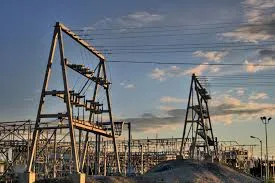Power Generation, Transmission, and Distribution - The generation of electrical power is a process where The Other form of energy transforms into electrical energy. there are several ways to transform The Other form of energy into electrical energy, out of all those ways one of the most ways is the electromechanical way.
In this method of transforming, the energy stored in coal, petroleum, natural gas, and radioactive substance, etc is converted into mechanical energy and then mechanical energy is converted into electrical energy by means of using the generator.
In this method of transforming, the energy stored in coal, petroleum, natural gas, and radioactive substance, etc is converted into mechanical energy and then mechanical energy is converted into electrical energy by means of using the generator.
In the electromechanical energy conversion method, a synchronous AC generator is used. the synchronous AC generator is coupled with a turbine in such a way that when the turbine converts steam, gas, or water flow into rotational energy, the synchronous generator is connected with the turbine and convert the rotational energy into electrical energy.
The operating cost of generating electrical energy is calculated by the fuel cost and the efficiency of the power station. After power generation, the most important task is conservation and transmission of power.
the transmission system is generally categorized into two categories AC and DC transmission systems. The power Grid is the main part of the transmission system. The generated power in the power station is sent to a substation for utilization by the power grid.
The operating cost of generating electrical energy is calculated by the fuel cost and the efficiency of the power station. After power generation, the most important task is conservation and transmission of power.
the transmission system is generally categorized into two categories AC and DC transmission systems. The power Grid is the main part of the transmission system. The generated power in the power station is sent to a substation for utilization by the power grid.
Source of energy
Energy is a physical quantity and is defined as that has the capability to do some work but in engineering, it is a property of an object which is transferable among them via fundamental interaction and can be converted into different form but neither it can be created nor be destroyed.
The generation of electrical power is a process where The Other form of energy transforms into electrical energy. there are several ways to transform The Other form of energy into electrical energy, out of all those ways one of the most ways is electromechanical conversion.
In this method of transforming, the energy stored in coal, petroleum, natural gas, and radioactive substance, etc is converted into mechanical energy and then mechanical energy is converted into electrical energy by means of using the generator.
In this method of transforming, the energy stored in coal, petroleum, natural gas, and radioactive substance, etc is converted into mechanical energy and then mechanical energy is converted into electrical energy by means of using the generator.
In the electromechanical energy conversion method, a synchronous AC generator is used. the synchronous AC generator is coupled with a turbine in such a way that when the turbine converts steam, gas, or water flow into rotational energy, the synchronous generator is connected with the turbine and convert the rotational energy into electrical energy.
The operating cost of generating electrical energy is calculated by the fuel cost and the efficiency of the power station. After the power generation, the most important task is the conservation and transmission of power.
the transmission system in general categories into two categories AC and DC transmission systems. Power Grid is the main part of the transmission system. The generated power in the power station is sent to a substation for utilization by the power grid.
the transmission system in general categories into two categories AC and DC transmission systems. Power Grid is the main part of the transmission system. The generated power in the power station is sent to a substation for utilization by the power grid.
Source of energy
Energy is a physical quantity and is defined as that has the capability to do some work but in engineering, it is a property of an object which is transferable among them via fundamental interaction and can be converted into different form but neither it can be created nor be destroyed. the various source of energy given below:-
- Fuel
- Hydro energy
- Solar energy
- Wind energy
- Nuclear energy
- Tidal energy
- Thermoelectric Power
- Geothermal energy
Conventional and Non-conventional source of energy
The sources of energy which are being used traditionally for a long time. these sources are exhaustible are non-renewable. like Coal, petroleum products, natural gas, and radioactive substance
These sources of energy are types of energy that are not in use traditionally. these sources of energy are inexhaustible or renewable, which means it can be used to produce energy again and again.like solar energy, wind energy, geothermal energy, etc.
Also Read,
